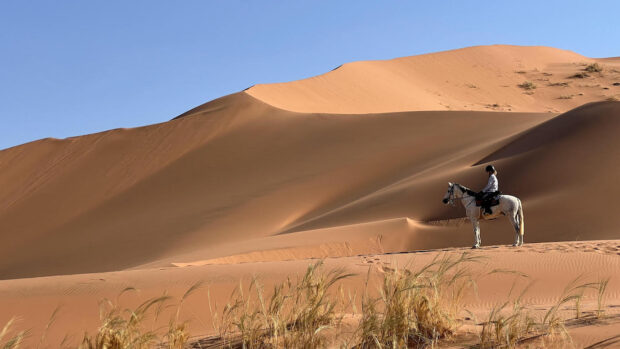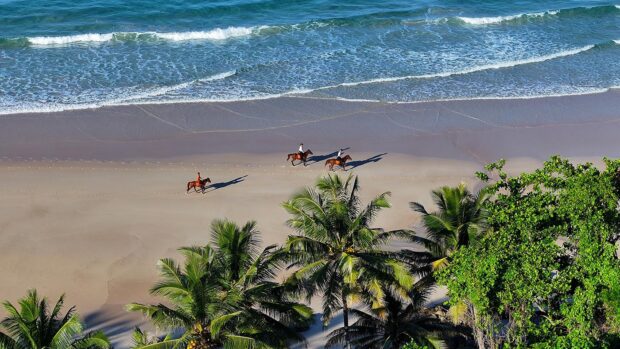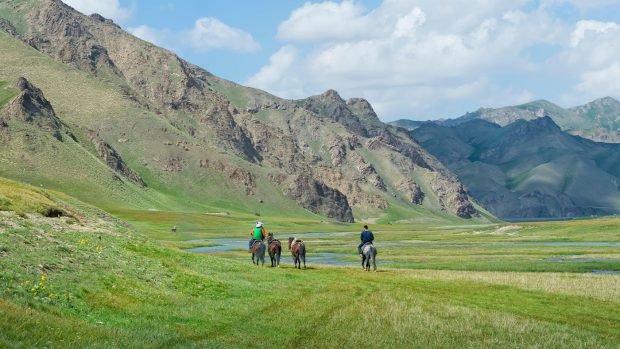Forget large military 4x4 vehicles or helicopters — Struan Chisholm and Calum Nicoll recount their experience of crossing south-eastern Kyrgyzstan by horse (and the challenges they encountered along the way...)
Kyrgyzstan. Tucked between Uzbekistan, Kazakhstan, Tajikistan and China, few could place it on map. But those who have had the privilege of travelling there know it is a stunning country, with lush green plains and jagged, snow-capped peaks.
We were a team of six: Calum, Struan, Sandy, Mark, Sam and Neil. Most of us had been adventuring together since our school days in Inverness. This trip was planned to combine mountaineering (which we knew) and riding (which only one of us had experienced prior to the expedition).
Where better than Kyrgyzstan for combining horses and mountains?
It’s said that the Kyrgyz are born on horseback. It is a land of nomads and yurts. Glaciers, icy rivers, thunder storms, climbing, loose rock, ice axes, stirrups — and dried meals.
Most expeditions to the Kyrgyz mountains use large military 4×4 vehicles or helicopters, so by taking horses, we were pioneering a new approach. The only information we could find about our target mountain range stated “the range is barely explored… There are about 50 unclimbed peaks over 4,000m”. It was about 90km of riding from the nearest road. Perfect.
So, in July and August 2016, we rode across south-eastern Kyrgyzstan on horseback, exploring the little-known Djenghi-Djer mountain range and climbing first ascents of the snowy peaks, reaching as high as 4,436m.
Here is what we learnt…
1. Horses are the mode of transport for mountaineering expeditions

Logistically, the horses were hugely beneficial. The advantages over motor or foot transport were numerous. Riding allowed us to access the mountains quickly and with great flexibility, averaging between 5km/hr and 8km/hr, with no breaks, covering terrain which could not be covered on foot (for example crossing rivers in spate) or by vehicle (for example right up to the foot of the moraine). Rather than draining energy and time on long approaches, we conserved both for ascents. We were able to strike and saddle the entire base camp within two hours, to relocate it or retreat in case of emergency. This speed would not have been possible had we used an expedition vehicle or helicopter, which would usually have to be arranged in advance.
2. Horses aren’t good ice climbers
Mountaineers traversing ice and snow use crampons (blades) on their boots, to avoid slipping. Horse shoes didn’t give the horses enough purchase to make progress over glaciers. Although very sure-footed, they were largely confined to below the scree level and had to be led over moraines.
3. Kyrgyz horses : the energy premium
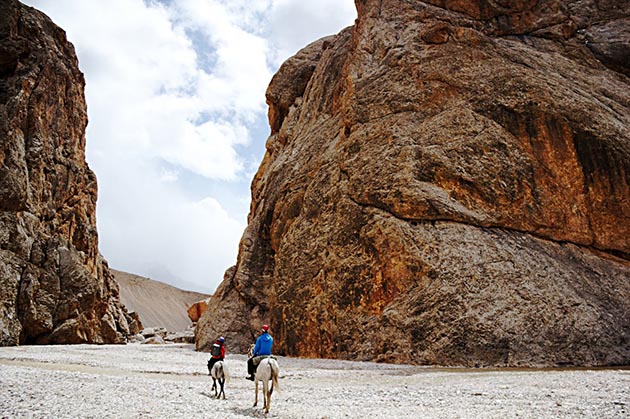
One of us had a horse which exceeded all the others in its capacity to cause trouble. This horse (‘Red Bull’) left the others trailing in the dust on a gallop, and brimmed with energy to the extent that it was hard to stop it once it broke into a canter. On the last day of riding, this horse made one last break for freedom — galloping straight at the heavily armed military checkpoint. The horsemen told us to be careful with this horse, as it was worth 10 times as much as the others.
4. Never, ever ride in mountaineering boots
One of our horses sat down on the plain, rolled over on its rider before he could get off, and then bolted, dragging the rider along for several metres and kicking him repeatedly. The rider, Neil, was wearing mountaineering boots and was unable to slip his foot swiftly out of the stirrup. We learnt by experience the importance of wearing riding boots or footwear with a heel and smooth sole, rather than mountaineering boots, while riding.
5. Watch out for stray hooves
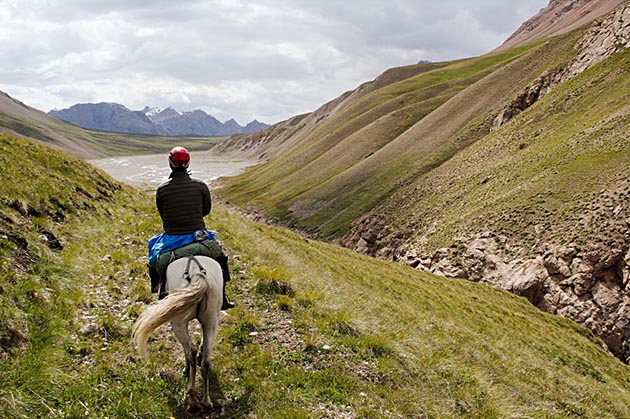
As all regular horse riders know, you should be complacent around horses. One evening after dismounting, a horse decided to try and take a bite out of another – the other one reacted and sent one of us flying with its rear hoof!
6. Watch out for biting insects
One morning as the sun rose after several days of rain, we were swarmed by flies, cleggs and other biting beasties. We learned the hard way to prevent biting insects from landing on the horses (after being bucked off…)
Like this? You might also enjoy reading these:
7. Beware of wolves
While not a threat to groups of people, the Kyrgyz wolves certainly spooked our horses when they paced close to us as we rode one day. More often, you’ll just hear them howling in the distance.
8. Horses sweat heavily at altitude
Remember that if you’re breathless at altitude, your horse will be breathless, too. Sweat was pouring off the horses even when ascending at a slow pace in the thin air above 3,500m. Allow more time for the horses to have water and grass rests.
9. Kyrgyz riding involves multi-tasking
We watched in awe as a local Kyrgyz farmer perched on his horse reached down into a stream, whilst hanging on with his legs wrapped round the saddle, and snatched a fish with his bare hands. We weren’t able to reproduce this feat…

